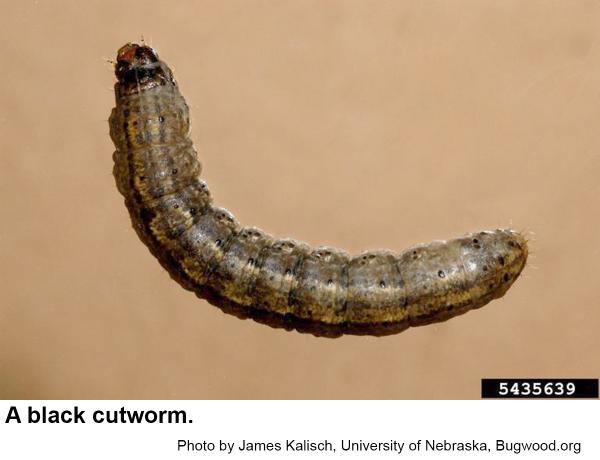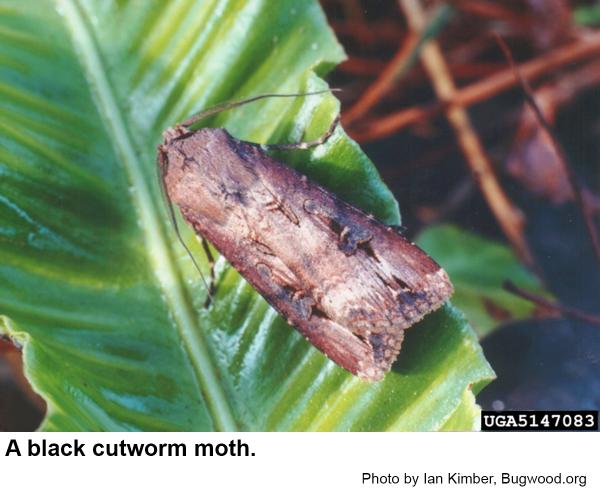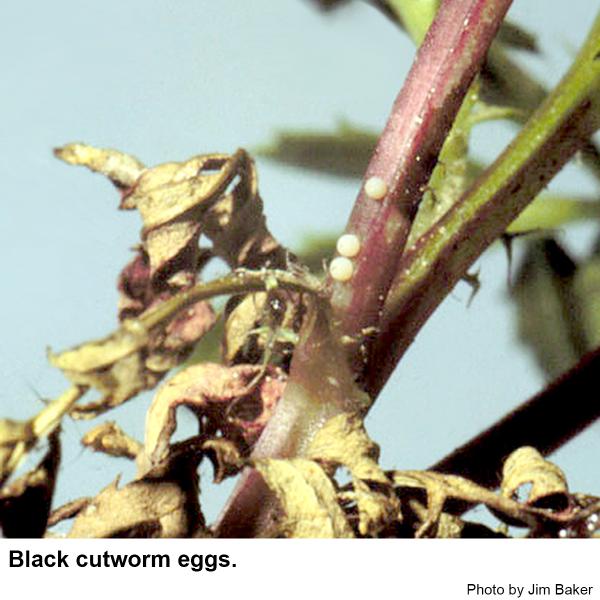Description and Biology
Black cutworms, Agrotis ipsilon, tend to cut off seedlings and then consume them in burrows up to four inches deep. They hide during the day. Black cutworms vary from light gray to nearly black. Fully grown black cutworms are almost two inches long. The spiracles are distinctly black. When disturbed, the larva characteristically curls up into a spiral. Black cutworm moths are dark but the wings may be pale near the tips. Three black dashes mark each forewing. Hind wings are white with dark veins and broad, dark margins. Females each lay 1,000 or more eggs sometimes in clusters. Eggs are white and round. They darken at the embryo matures inside. The pupae are oblong, brown, and found in the soil. There is no cocoon. Black cutworms pass the winter as pupae or caterpillars in the soil. We have three to four generations per year in North Carolina. Considerable overlap of generations occurs in late summer and fall.
Host Plants
Black cutworms feed on a wide range of ornamental, turf, garden, and field crops as well as chickweed, curly dock, mustard and many other weeds. They are considered among the most destructive of all cutworms. Larvae sever plants from roots near the soil line; usually no other feeding damage is present. Many larvae move from plant to plant on successive nights but some stay to feed on the roots and underground stems of cut plants. Black cutworm moths feed on nectar from flowers, shrubs, and trees.
Residential Recommendations
Black cutworms are plagued by parasitic wasps, flies, and nematodes. Ground beetles also prey upon them. Diseases caused by bacteria, viruses, fungi, and protozoa also exact a toll on their population. These natural controls may explain why black cutworm populations are highly variable.
If black cutworms have been a problem in prior years, consider using bait traps. Traps are most effective prior to emergence or planting of seedlings. A container sunk into the soil with the upper lip at the soil surface can be baited with fresh plant material or bran, and vermiculite so the larvae can attain shelter. Catches are enhanced if a screen cylinder is suspended above the baited container.
Once seedlings are up or bedding plants newly set out, consider using metal or waxed paper barriers around plant stems (for example, tin cans with both ends removed). Aluminum foil can be wrapped around stems instead, but this seems to more labor intensive. Because larvae burrow and feed below the soil line jam the barrier below the soil surface.
Because black cutworms feed on a huge variety of weeds and other host plants many of which are never sprayed for insect control, it is unlikely that this species has acquired resistance to pesticides. Most insecticides labeled for landscape use should give adequate control of black cutworms.
References
- Common name: black cutworm, scientific name: Agrotis ipsilon (Hufnagel) (Insecta: Lepidoptera: Noctuidae). Capinera, J. L. 2012 (revised). Featured Creatures, Entomology & Nematology, FDACS/DPI, EDIS. Publication Number: EENY-395.
- Insect and related Pests of Flowers and Foliage Plants. Baker, J. R., ed. 1994. North Carolina Cooperative Extension Service Publication AG-136. 106 pp.
- Insect and related pests of vegetables. Sorensen, K. A. and J. R. Baker eds. 1994. North Carolina Agricultural Extension Service publication AG-295. 180 pp.
- Extension Plant Pathology Publications and Factsheets
- Horticultural Science Publications
- North Carolina Agricultural Chemicals Manual
For assistance with a specific problem, contact your local Cooperative Extension Center
This Factsheet has not been peer reviewed.
Publication date: April 13, 2016
Reviewed/Revised: Sept. 11, 2019
Recommendations for the use of agricultural chemicals are included in this publication as a convenience to the reader. The use of brand names and any mention or listing of commercial products or services in this publication does not imply endorsement by NC State University or N.C. A&T State University nor discrimination against similar products or services not mentioned. Individuals who use agricultural chemicals are responsible for ensuring that the intended use complies with current regulations and conforms to the product label. Be sure to obtain current information about usage regulations and examine a current product label before applying any chemical. For assistance, contact your local N.C. Cooperative Extension county center.
N.C. Cooperative Extension prohibits discrimination and harassment regardless of age, color, disability, family and marital status, gender identity, national origin, political beliefs, race, religion, sex (including pregnancy), sexual orientation and veteran status.




